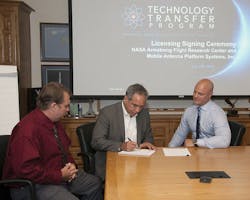NASA licenses new auto-tracking mobile antenna platform, well suited to UAS
EDWARDS, Calif., 17 Aug. 2016. NASA has designed an innovative antenna-mounting platform that meets the needs of the unmanned aircraft systems (UAS) market by providing a low-cost, low-power mobile auto-tracking antenna.
The patent-pending platform offers continuous rotation of nearly 60 pounds of antennas, transmitters, and receivers along with customized software to automatically track a target such as an unmanned aerial vehicle (UAV), also commonly referred to as a drone, which can be any size aircraft.
"This technology is the perfect example of a NASA engineer thinking outside of the box to create a solution to a problem that benefits not only NASA, but industry as well," says Laura Fobel, chief of Armstrong's technology transfer office. "We are looking forward to working with Mobile Antenna Platform Systems Inc. to commercialize this technology."
Center Director David McBride at NASA's Armstrong Flight Research Center in Edwards, California, signed a license agreement for the NASA antenna platform with Director of Business Strategy Jason Pottinger of Mobile Antenna Platform Systems Inc. in Tampa, Florida.
The portable antenna platform is lightweight and uses inexpensive means to track an object or UAV. Ground-based tracking uses information from a ground-tracking asset such as a radar, which is incredibly expensive. Satellite-based tracking like this mobile antenna platform uses a global positioning system (GPS).
The unique and simple to set-up design of the platform eliminates the need for additional load balancing hardware, which allows for more space to add additional antennas and equipment. No counterweights means less mass, which enables the use of smaller, cheaper, and lighter motors to turn all the antennas. The mobile platform also makes it easier for one person to carry it.
Another benefit is the use of a one-slip ring assembly, an electromechanical device to transmit power and electrical signals, which are much less expensive than radio frequency rotary joints that now exist on current high-power tracking systems. The slip ring assembly passes power and data, not RF, so any frequency radios can be used with this tracking antenna platform without changing any platform hardware.
The auto tracking software uses the target's GPS, location to coordinate and maintain a line-of-sight link with the object being tracked. The maximum tracking distance to the object is as great as what the telemetry system, radios and antennas, can support as long as the object does not disappear below the horizon.
A much smaller version of this platform may be flown on a plane, which would greatly extend the telemetry link range without requiring more power from the aircraft.
Besides tracking UAVs, this platform offers many other applications for Earths' atmospheric and university research, marine communication and satellite tracking that transmit multiple frequencies as well as weather balloon tracking.
Search the Aerospace & Defense Buyer's Guide
You might also like:
Subscribe today to receive all the latest aerospace technology and engineering news, delivered directly to your e-mail inbox twice a week (Tuesdays and Thursdays). Sign upfor your free subscription to the Intelligent Inbox e-newsletter at http://www.intelligent-aerospace.com/subscribe.html.
Connect with Intelligent Aerospace on social media: Twitter (@IntelligentAero), LinkedIn,Google+, and Instagram.
Intelligent Aerospace
Global Aerospace Technology NetworkIntelligent Aerospace, the global aerospace technology network, reports on the latest tools, technologies, and trends of vital importance to aerospace professionals involved in air traffic control, airport operations, satellites and space, and commercial and military avionics on fixed-wing, rotor-wing, and unmanned aircraft throughout the world.



